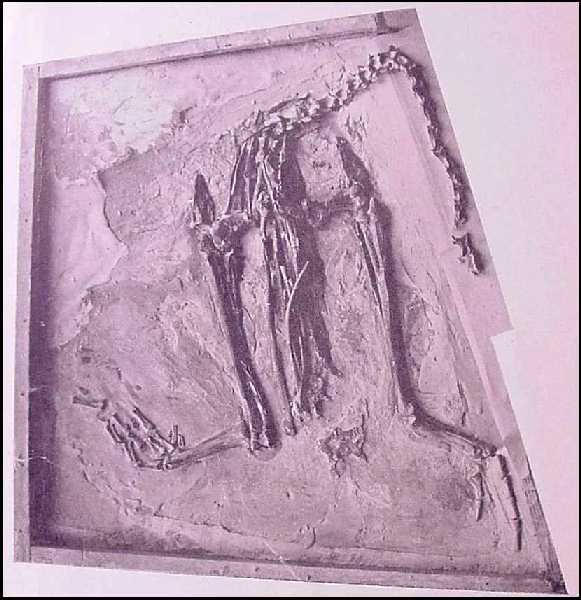 |
MARSH, O. C.
1872
Discovery of a remarkable fossil bird
American Journal of Science, Series 3, 3(13):56-57
Copyright © 2003-2009 by Mike Everhart
ePage created 03/11/2004; Last updated 02/14/2009
LEFT: A relatively complete but headless
specimen of Hesperornis regalis discovered by C. H. Sternberg's son, Charles M.,
in 1907 near Twin Butte Creek in the Smoky Hill Chalk of Logan County, Kansas; in the
collection of the American Museum of Natural History (AMNH FR 5100). |
Wherein a brief note written by O. C. Marsh relates the November
1871 discovery of the first Cretaceous bird fossil from west of the Mississippi
River. The specimen was without a skull (much like the Sternberg's later discovery -
above) and it would be several years before anyone realized that Hesperornis had teeth. Professor
Mudge found the first bird with teeth (Ichthyornis dispar) a year later.
| 56
Scientific Intelligence II. Geology and Natural
History
1. Discovery of a remarkable fossil bird; by
Professor O. C. Marsh. (From a letter to Professor Dana, dated San Francisco, Cal. Nov.
29, 1871.) -- One of the treasures secured during our explorations this year was the
greater portion of the skeleton of a large fossil bird, at least five feet in height,
which I was fortunate enough to discover in the Upper Cretaceous of Western Kansas. This
interesting specimen, although a true bird --- as clearly as shown by the vertebræ and
some other parts of the skeleton -- differs widely from any known recent or extinct forms
of that class, |
Geology and Natural History
57
and affords a fine example of a comprehensive type. The bones are all well
preserved. The femur is very short, but the other portions of the legs are quite
elongated. The metatarsal bones appear to have been separated. On my return, I shall
fully describe this unique fossil under the name Hesperornis regalis.
3.
|
Suggested references on Cretaceous birds:
Bühler, P., L. D. Martin and L. M. Witmer. 1988. Cranial kinesis in
the Late Cretaceous birds Hesperornis and Parahesperornis. Auk 105 p.
111-122.
Chinsamy, A., L. D. Martin and P. Dodson. 1998. Bone
microstructure of the diving Hesperornis and the volant Ichthyornis from
the Niobrara Chalk of western Kansas. Cret. Research 19:225-235.
Gingerich, P. D. 1973. Skull of Hesperornis and early evolution of
birds. Nature 243: 70-73
Gregory, J. T. 1951. Convergent evolution: The jaws of Hesperornis and
the mosasaurs, Evolution, 5:345-354.
Gregory, J. T. 1952. The jaws of the
Cretaceous toothed birds Ichthyornis and Hesperornis. Condor
54(2):73-88, 9 figs., 1 table.
Lane, H. H. 1946, A survey of the fossil vertebrates of Kansas, Part
IV, The Birds, Kansas Academy Science, Transactions 49(4):390-400.
Lucas, S. G. 1982. Ichthyornis in the Late Cretaceous Mancos
Shale (Juana Lopez Member), Northwest New Mexico. Journal of Paleontology 56(2):545-547.
Marsh, O. C. 1870. [Cretaceous and Tertiary birds of the U.S.] Nature
(London), 1:546.
Marsh, O. C. 1872. Discovery of a remarkable
fossil bird. American Journal of Science, series 3, 3(13):56-57. (for January - Hesperornis)
Marsh, O. C. 1872. Preliminary description of Hesperornis regalis,
with notices of four other new species of Cretaceous birds. American Journal of Science,
series 3, 3(17):360-365.
Marsh, O. C. 1872. Notice of a new and
remarkable fossil bird. American Journal of Science, series 3, 4(22):344. (Ichthyornis)
Marsh, O. C. 1872. Notice of a new reptile
from the Cretaceous. American Journal of Science, series 3, 4(23):406.
Marsh, O. C. 1873. Fossil birds from the Cretaceous of North America.
American Journal of Science, series 3, 5(27):229-231.
Marsh, O. C. 1875. On the Odontornithes, or birds with teeth. American
Journal of Science, series 3, 10(59):403-408, pl. 9-10.
Marsh, O. C. 1875. Odontornithes, or birds with teeth. American
Naturalist. 9(12):625-631, pl. 2-3.
Marsh, O. C.
1880. Odontornithes:
A monograph on the extinct toothed birds of North America. U.S. Geological Expl. 40th
Parallel (King), vol. 7, xv + 201 p., 34 pl. (Synopsis of American Cretaceous birds,
appendix 191-199)
Marsh, O. C. 1883. Birds with Teeth. 3rd Annual Report of the
Secretary of the Interior, 3: 43-88. Government Printing Office, Washington, D.C.
Martin, J. E.
1982. The occurrence of Hesperornis in the late
Cretaceous Niobrara Formation of South Dakota. Proceedings South Dakota Academy of Science
Martin, L. D. 1981. The skeleton of Baptornis advenus from
the Cretaceous of Kansas, Smithsonian Contributions Paleobiology 27:36-66.
Martin, L. D. 1984. A new hesperornithid and the relationships of the
Mesozoic birds. Kansas Academy Science, Transactions 87:141-150.
Martin, L. D., and J. D. Stewart. 1977. Teeth in Ichthyornis
(Class: Aves). Science, 185(4284):1331-1332.
Martin, L. D. and J. D. Stewart. 1982. An ichthyornithiform bird from
the Campanian of Canada. Canadian Journal of Earth Science 324-327.
Martin, L. D. and J. D. Stewart. 1996. Implantation and replacement of bird
teeth. Smithsonian Contributions to Paleobiology 89:295-300.
Martin, L. D. and J. Tate Jr. 1966. A bird with teeth. Museum Notes, University of Nebraska
State Museum, 29:1-2.
Walker, M. V. 1967. Revival of interest in the toothed birds of
Kansas. Kansas Academy of Science, Transactions 70(1):60-66.
Williston, S. W. 1898. Addenda to Part I.
The University Geological Survey of Kansas, 4:28-32.
Williston, S. W. 1898. Birds. The University
Geological Survey of Kansas, Part II, 4:43-53, pls.5-8.


